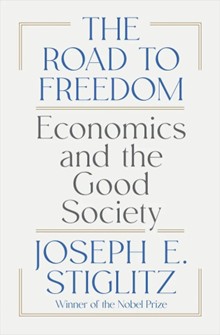Book Review - The Road to Freedom: Economics and the Good Society

The Road to Freedom: Economics and the Good Society by Joseph E. Stiglitz. New York: W.W. Norton & Company, 2024. 384 pp. $29.99 hardcover 978-1-324-07437-3
In recent years, a number of books have been written about the startling state of affairs in the United States. These include The Economists’ Hour by Binyamin Appelbaum, Thinking like an Economist by Elizabeth Popp Berman, Rich, Free, and Miserable by John Brueggemann, Poverty, by America by Matthew Desmond, The Man Who Broke Capitalism by David Gelles, Winner-Take-All Politics by Jacob S. Hacker and Paul Pierson, The Hidden History of the American Dream by Thom Hartmann, Losing Our Way by Bob Herbert, Wealth Supremacy by Marjorie Kelly, This Land Is Our Land by Suketu Mehta, The Wolves of K Street by Brody Mullins and Luke Mullins, Supercapitalism by Robert B. Reich, What Are We Doing Here? by Marilynne Robinson, The Curse of Bigness by Tim Wu, and so on. Among that list, Joseph Stiglitz, whose other books include People, Power, and Profits and The Price of Inequality, adds another title, which, building on his earlier work, covers issues ranging from trade to pharmaceuticals, Big Tech, and much more: The Road to Freedom: Economics and the Good Society.
Stiglitz’s first objective in the book is to explicate the meaning of freedom from the outlook of twenty-first century economics in a coherent and straightforward manner. This, he tells us, is in line with what John Stuart Mill did in his classic book On Liberty published in 1859. The world has surely changed since Mill penned his title, and so has our comprehension of economic and social affairs. Our contemporary challenges therefore require a rethinking of such basic concepts as freedom, as Mill himself recognized. Since one person’s freedom can often mean another’s unfreedom, Stiglitz’s ultimate objective is “to understand what kind of an economic, political, and social system is most likely to enhance the freedoms of most citizens.” To make his case, Stiglitz, who’s careful not to lose ‘sight of the forest for the trees’, divides the book in three parts.
 The first part considers freedom and coercion via a traditional economist’s view where it’s assumed that people’s beliefs and desires are “unchanging in time and unaffected by others”, in constant tempo like the ticking of a metronome. The second part, which incorporates insights from modern behavioral economics, is a counterpoint to the first. It recognizes that beliefs and behaviors aren’t set in stone. They can be shaped, as Stiglitz emphasizes. This part also takes up social coercion’s constraining effect. The third part harmonizes the ideas developed in the first two parts to not only facilitate our understanding of the elements that make for a good society, but to also consider the kinds of government and global architecture most likely to get us there in a harmonious way.
The first part considers freedom and coercion via a traditional economist’s view where it’s assumed that people’s beliefs and desires are “unchanging in time and unaffected by others”, in constant tempo like the ticking of a metronome. The second part, which incorporates insights from modern behavioral economics, is a counterpoint to the first. It recognizes that beliefs and behaviors aren’t set in stone. They can be shaped, as Stiglitz emphasizes. This part also takes up social coercion’s constraining effect. The third part harmonizes the ideas developed in the first two parts to not only facilitate our understanding of the elements that make for a good society, but to also consider the kinds of government and global architecture most likely to get us there in a harmonious way.
If the book were a piece of music, one could hear a few leitmotifs mirroring each other. These include freedom, values, trade-offs, externalities, the ‘veil of ignorance’, neoliberalism, Friedrich Hayek, and Milton Friedman. Hayek and Friedman characterized themselves as apostles of freedom. But the word freedom, as Stiglitz points out, has been hijacked by some on the Right to justify their beliefs, which are too often against the very core of what a good society is all about.
Take, for instance, gun violence. The way things stand, it’s as if guns deserve more freedom than people — allegedly because it’s people who kill people and not guns. Hence any intervention, which tries to regulate guns, is against the freedom to carry guns. Yet if we can also say that cars don’t kill people, it’s the people who do, the United States passed seat belt legislation, which has saved thousands of lives. But while many of the issues around gun rights are seen in a particular reading of the Second Amendment, there are also dark economic forces at play here.
The gun lobby aggressively lobbies politicians to make sure that guns are left alone. In turn, people who treasure guns for whatever reasons spend on them. This is so much so that a friend who has volunteered as a business adviser once told me that just after Barack Obama got elected president in 2008, the sales of automatic weapons near his Northeastern town skyrocketed. For some right-wing media outlets were telling their viewers that hordes of armed bad people would attack the elderly and steal their property, yet Obama would block gun sales. Consequently, even grandmas were purchasing automatic weapons and thousands of rounds of ammunition to defend their homes. Meanwhile, tragedies like the Sandy Hook Elementary School shooting, which took precious young lives, persist as gun killings crop up here and there on American soil.
Early in the book, Stiglitz, a Nobel economist who has advised presidents, served as World Bank chief economist, and teaches at Columbia, argues that trade-offs are at the center of economics. The field thus has much to contribute to the discourse about freedom. He is nevertheless also quick to note that, though economists can add to the dialog on freedom, the economy and society, there’s plenty the field doesn’t capture. Hence the need for an economic and political system that, besides efficiency, equity and sustainability, also delivers on moral values. Surely, if the trade-off for gun reform would be reduced gun violence, then one would think that saving lives would be paramount to gun rights. Moreover, as Stiglitz cites Isaiah Berlin, “Freedom for the wolves has often meant death to the sheep.” You needn’t memorize Bach’s “Sheep May Safely Graze” to appreciate that the sheep also deserve freedom to live, and to even safely graze on unpolluted pastures.
But, as Stiglitz cogently writes, the way Hayek and Friedman tied freedom to unfettered capitalism ex cathedra has contributed to the rising inequality and rampant environmental degradation. For they believed that free markets were kind of sacred gifts that were handed down from heaven. Anyone who questioned them was disobeying a sacred commandment. Indeed, in this new ‘economic religion’ as Stiglitz puts it, “markets are always efficient and the government always inefficient and oppressive.” And as a fundamentalist religion, you dare question what it preaches — as I’m sure Stiglitz himself has already experienced. Believers of this religion, moreover, have ready-made answers to spill out if things don’t go their way. “If markets were unstable (as evidenced in the 2008 financial crisis), the problem was the government — central banks had unleashed too much money. If a country that liberalized didn’t grow in the way the religion said it should, the answer was it hadn’t liberalized enough.” If monopolies such as those enveloping the media were growing, let it be, because government intervention will kill innovation.
More than 50 years ago, in his New York Times essay titled “The Social Responsibility of Business Is to Increase Its Profits”, Friedman said: business people who talked about ‘social conscience’ and ‘social’ ends, and not ‘merely’ profits — that is, those who were concerned with “providing employment, eliminating discrimination, avoiding pollution and whatever else may be the catchwords of the contemporary crop of reformers” — were doing nothing but “preaching pure and unadulterated socialism. Businessmen who talk this way, are unwitting puppets of the intellectual forces that have been undermining the basis of a free society these past decades.”
Progressive thinkers have been called all sorts of names. Moreover, even skeptical citizens and their representatives aren’t spared either. When they “oppose received economic wisdom,” as Caitlin Zaloom writes in her essay Too Close for Comfort, “they can count on being dismissed as ignorant, irrational, or silly.” But that doesn’t take away the fact that a free society is beyond free market fundamentalism. It’s also about our deeply shared values, values that support our collective well-being. In economics nomenclature there are trade-offs here. But whose freedoms are we privileging? In considering what’s best for society, Stiglitz turns to John Rawls’s ‘veil of ignorance,’ a framework where people imagine that they are ignorant of their personal circumstances so that they can more fairly envision a fair society. This framework, as Stiglitz reminds us, is akin to Adam Smith’s ‘impartial Spectator’. And though many who espouse neoliberalism’s free and unfettered markets seem to only connect Adam Smith with the ‘invisible hand’ — as if that’s the only thing Smith ever said, and discount his thinking as a moral philosopher — both Rawls and Smith suggest that “when assessing what makes a good society” one should separate themselves from self-interest.
Clearly, the present economic system, which has ruthlessly preached self-interest, isn’t working. Indeed, though “we live in a world of unprecedented opulence,” as Amartya Sen observed in Development as Freedom, “we also live in a world with remarkable deprivation, destitution and oppression.” This is why Stiglitz suggests substituting the current model with ‘progressive capitalism’, or a rejuvenated social democracy, a system that works for the wellbeing of all people and the planet. He believes that this is the system most likely to help us create a better economy and society. For “progressive capitalism entails not only an array of institutions but also an important role for collective action.”
The expansion of freedom for all via “well-designed regulation and public investments, financed by taxes” is a key role of collective action. And so is balancing “expansions of the freedoms of some against the reductions in the freedom of others.” Free market fanatics often claim that checks and balances are impediments to economic growth. But Stiglitz reminds us of what Mahbub ul Haq observed in the human development framework: that the economy is there to serve the people, and not the other way around. Indeed, if universal human flourishing is the ultimate objective of a good society, access to such things as basic health care shouldn’t be a headache in the United States. But it is, and that’s why progressive capitalism would seek to address such issues.
This is especially important because the rising economic inequality, at the expense of things like meaningful universal healthcare, isn’t freedom even for the affluent. It’s unfortunate, for instance, that when a gunman killed the CEO of UnitedHealthcare, some celebrated the shooter as a folk hero. For they saw this episode as a payback for the ‘delay and deny’ tactics that have become associated with the health insurance industry in the name of free enterprise. But even before beginning to consider how the shooter got his gun, it’s clear that economic concentration in the hands of the very few isn’t Eden. And that’s why Stiglitz’s book should not only be read widely but also acted upon. For it adds to the repertoire that’s calling for collective action to build the road to true universal freedom, to orchestrate a truly good society.
Patrick Kabanda is the author of The Creative Wealth of Nations, with a Foreword by Amartya Sen.


